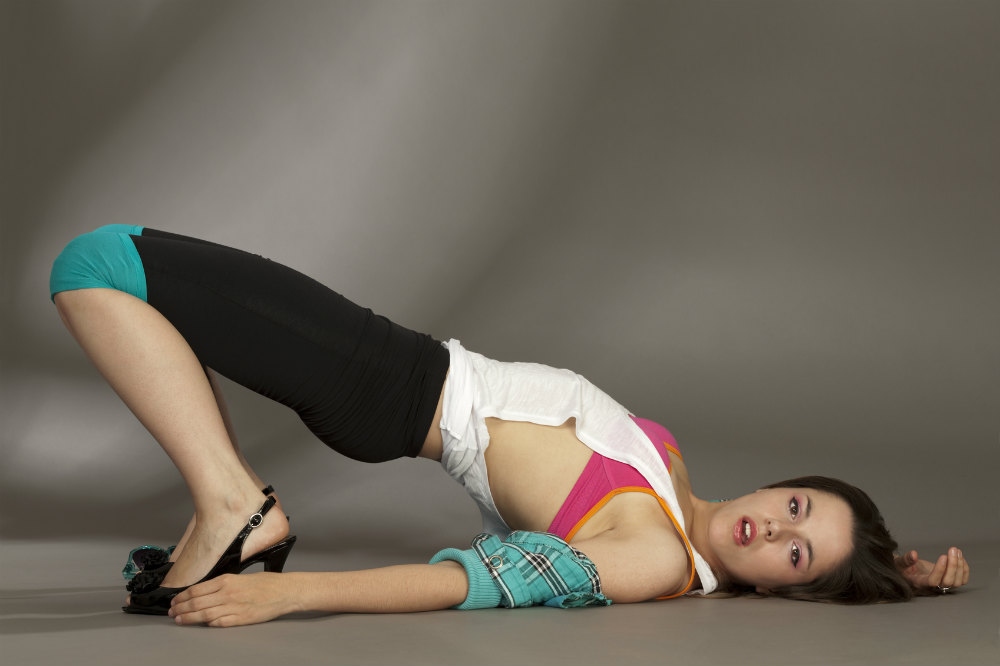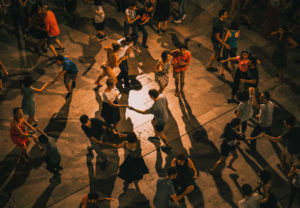As a certified yoga instructor, I’m often asked, “What’s the best asana (pose) for (fill in the blank)?” Salsa dancers, runners, boxers, cyclists, power lifters, and those tied to their desk 60+ hours per week all want to know the “best” poses to correct the side effects of their lifestyles. No matter what you do, or don’t do, your body is going to be hungry for counter-poses. For example, runners notoriously have tight leg muscles—they need that tightness to protect their bodies during long runs! I was shocked when I began training for my first marathon. It had always been easy and natural for me to drop into a squat where my heels touched the floor. After just one month of marathon training, I could no longer get my heels to reach the floor.
So, what are the best yoga poses for salsa dancers? The short answer is all of them! A regular yoga practice is for life, and there’s no such thing as mastering a pose. Still, there are some troubles that salsa dancers experience more than non-dancers. Practicing yoga increases your balance, flexibility, strength, endurance, and ability to concentrate. In other words, it’s the perfect complement to dancing.
Even better, the pranayama aspect of yoga (breath exercises) can help you sustain your dance, keep calm during competition, and better your lung capacity during those grueling all-night dance parties. The better you breathe, the better you can calm yourself, de-stress, and keep your heart rate in check.
For those who are new or beginning yogis, add these poses to your routine to optimize both your salsa dancing and yoga practice:
1. Bridge pose/Wheel: A strong back is a must for a salsa dancer, especially if you’re working on flair and want to really nail those dips. Bridge pose (and perhaps eventually wheel) powers up your back and helps you regain that true “C-shape” you’re meant to have in your spine. Ideally, each vertebrae moves independently, but due to lack of use, most adults have a spine with at least some joints “fused” together. You can tell by rocking gently frontwards and backwards along your spine. Do you feel or hear a flat spot that slaps against the floor? That’s where your vertebrae aren’t acting independently.
Beginning bridge pose, where you lift your hips into the air while keeping the top of your back (shoulder area) on the floor is a great way to make your back stronger. You can then graduate to tucking your shoulders and intertwining your fingers below your back, and maybe eventually transition into full wheel. Just bear in mind that there’s nothing special about wheel or any advanced pose. All forms of bridge and wheel will help keep your back strong, healthy, and better capable of dips, spins and salsa.
2. Horse: It’s no surprise that salsa dancers rely on their legs. Every muscle in your lower body is used in salsa, particularly for dancers who wear higher heels (this goes for women and men alike). Horse taps into those under-worked upper leg muscles. The stronger they are, the more stamina you’ll have on the dance floor. Work towards getting your thighs as parallel to the floor as possible while keeping your back straight and upright. It’s often helpful to practice horse against a wall.
3. Mountain Pose: This pose is really just good posture, which everyone can and should work on! Proper mountain pose had you standing with legs hip distant apart (that’s hip bone, not the widest part of your hip flesh) with head, shoulder, butt and feet in alignment. It’s much more difficult than you think, especially in western culture where it’s common to be hunched over computers and phones all day. In fact, most people find that it feels really strange to have their head “so far back” to align with their spine.
Try standing against a wall and having your head, shoulders, butt and feet all touch the wall. Roll your shoulders back and down to achieve this. Close your eyes and memorize how this feels. This is good posture, and it’s going to feel very awkward at first. However, good posture is critical for salsa dancers. Have you ever seen a slouched over professional salsa dancer? There’s a good reason why.
4. Savasana: Ah, yes, savasana. Otherwise known as corpse pose, it can be either the most maddening part of yoga or the sweetest. It’s that time of class (the end!) when a lot of yogis new to practice slip out early or struggle to be still. In reality, yoga was crafted as a way to stretch out, tire out and work out your body in preparation for hours of meditation. Savasana doesn’t ask for hours—just a couple of minutes.
If you’re practicing at home, slip in a guided meditation, practice a pranayama that works with lying down (such as four part breathing), or chant silently in your head (this is where “Ohm” can come in handy). Savasana is actually one of the most difficult poses there is, and one of the most beneficial. It’s a few moments where you work towards mono-tasking, doing your best to clear your mind and honor your practice, your body and your life. How does this benefit salsa dancing? It’s simple: Honoring your whole body’s demand and need for just being helps create peace within yourself. A stressed out salsa dancer might be able to pull off a miraculously fiery performance, but that’s rare and largely luck. Usually, a stressed out salsa dancer will have trouble remembering moves, leading or following, advancing, or even showing up to class!
Yoga can help you achieve a better dance faster, but also benefits just about every other aspect of your life.


Leave A Reply